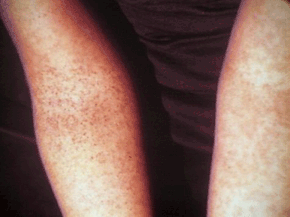For the constricting device, see tourniquet. Medical diagnostic method
| Tourniquet test | |
|---|---|
 A positive tourniquet test on the right side of a patient with dengue fever. Note the increased number of petechia. A positive tourniquet test on the right side of a patient with dengue fever. Note the increased number of petechia. |
A tourniquet test (also known as a Rumpel-Leede capillary-fragility test or simply a capillary fragility test) determines capillary fragility. It is a clinical diagnostic method to determine a patient's haemorrhagic tendency. It assesses fragility of capillary walls and is used to identify thrombocytopenia (a reduced platelet count) and is associated with low vitamin C or scurvy.
A blood pressure cuff is applied and inflated to the midpoint between the systolic and diastolic blood pressures for five minutes. The test is positive if there are more than 10 to 20 petechiae per square inch.
The test was once part of the World Health Organization (WHO) algorithm for diagnosis of dengue fever, however it is no longer used in the latest WHO guidance. Studies have shown that the tourniquet test has low predictive value for dengue fever and should be used in conjunction with other tests for a reliable diagnosis.
See also
References
- "Tourniquet test".
- Halstead SB (2008). Dengue. London: Imperial College Press. p. 180 & 429. ISBN 978-1-84816-228-0.
- WHO (2009). Dengue: Guidelines for Diagnosis, Treatment, Prevention and Control. World Health Organization. ISBN 978-92-4-154787-1.
- "Dengue Outbreak Toolbox". World Health Organization. September 2022. Retrieved 2024-03-07.
- Grande AJ, Reid H, Thomas E, Foster C, Darton TC (2016-08-03). "Tourniquet Test for Dengue Diagnosis: Systematic Review and Meta-analysis of Diagnostic Test Accuracy". PLOS Neglected Tropical Diseases. 10 (8): e0004888. doi:10.1371/journal.pntd.0004888. ISSN 1935-2727. PMC 4972435. PMID 27486661.
- Cao XT, et al. (2002). "Evaluation of the World Health Organization standard tourniquet test and a modified tourniquet test in the diagnosis of dengue infection in Viet Nam". Trop Med Int Health. 7 (2): 125–32. doi:10.1046/j.1365-3156.2002.00841.x. PMID 11841702. S2CID 42105522.
- Mayxay, et al. (2011). "Predictive diagnostic value of the tourniquet test for the diagnosis of dengue infection in adults". Trop Med Int Health. 16 (1): 127–33. doi:10.1111/j.1365-3156.2010.02641.x. PMC 3073123. PMID 20958892.
- Norlijah O, et al. (2006). "Repeated tourniquet testing as a diagnostic tool in dengue infection". Med J Malaysia. 61 (1): 22–27. PMID 16708730.